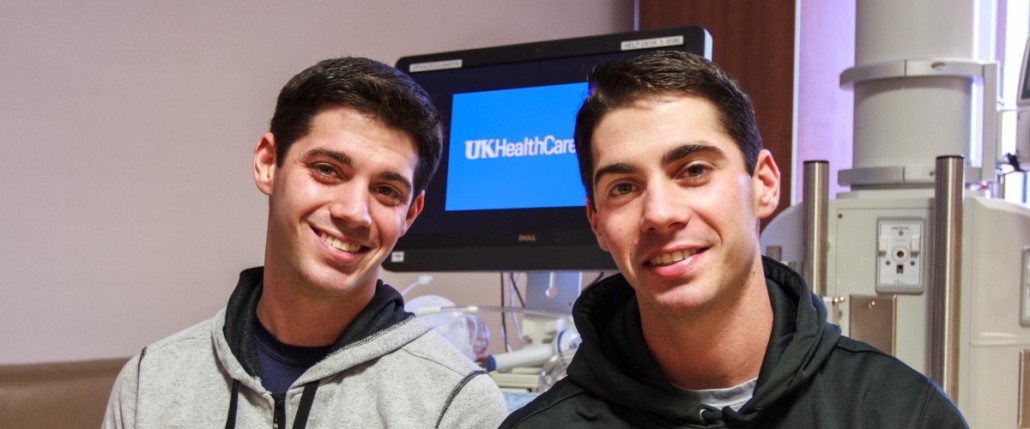Twin brothers’ rare heart condition sparks unique research opportunity

In 2015, identical twins Gardner and Jon Wes Adams, then in their mid-20s, both nearly died when their hearts suddenly stopped beating. The incidents happened months apart, but the cause was the same: Brugada syndrome, a rare congenital heart rhythm disorder.
Jon Wes’ heart stopped first while he was running at The Arboretum at UK. Bystander CPR kept him alive until emergency medical personnel arrived. At the UK Gill Heart Institute, doctors ran a battery of tests to determine why this healthy, physically fit young man went into sudden cardiac arrest.
As soon as the results indicated Brugada syndrome, the care team knew they needed to test Gardner, since he has the exact same genes as his twin brother. They weren’t surprised to find that he had the syndrome, too.
Understanding the role of genetics
By that time, Jon Wes had received an implantable cardioverter defibrillator (ICD) that could detect abnormal heart rhythms and provide an electrical shock to restore a normal heartbeat and prevent cardiac arrest. Gardner and the doctors decided that he should receive an ICD, too. While sudden cardiac arrest in Brugada syndrome is uncommon, the chances seem greater if it’s happened to a family member, especially one with identical genetic material.
Only months later, Gardner’s heart stopped while he was running, and the ICD saved his life.
This unusual clinical case – genetically identical twins with a rare heart condition – prompted one of their doctors to seek a greater understanding of Brugada. Genetic testing revealed a specific mutation behind the condition in Jon Wes and Gardner. The mutation causes the membrane of the heart cells to stop conducting the electrical current that powers the heart. It turned out that their non-twin brother and their father also had the mutation, but no symptoms. Elayi wanted to know why the condition was presenting so differently in family members with the same genetic mutation.
With support from a high-impact pilot award from the UK Center for Clinical and Translational Science, a multidisciplinary group of researchers are trying to find answers. The team includes Brian Delisle, PhD, associate professor of physiology and a recognized expert in the field of the basic mechanisms of congenital cardiac arrhythmias; Mark Farman, PhD, associate director of UK HealthCare Genomics and professor of plant pathology; and Jonathan Satin, PhD, professor of physiology. The case inverts the oft-quoted paradigm of “bench to bedside,” a reference to the trajectory of science that starts in the lab and then progress to patient care.
“This is a really fantastic opportunity because we have different members from a single family from whom we can get cells,” Elayi said. “We are trying to do a specific analysis of how what is really going on with this family and this gene because this disease is still very poorly understood.”
Testing blood cells
The research team is looking at cells from Jon Wes and his non-twin brother, as well as the rest of the family, with the hypothesis that there will be differences in each of them. Blood samples were sent to collaborators at the Stanford Cardiovascular Institute, where the blood cells are being transformed into inducible pluripotent stem cells (iPSC) – cells that can become any type of cell in body. The iPSCs will then be sent back to UK, where Satin will make them into heart cells that the team can study.
The team hopes to make a certain type of cardiomyocyte, or heart muscle cell, that few labs have been able to create. If they can do it, it would be a major advancement of this science at UK. They also hope that better knowledge of the genetic factors of Brugada could advance precision medicine in the field.
“This case is at the intersection of developmental biology, functional biology and molecular biology,” Delisle said. “Hopefully we can use this approach of reprogramming patient cells into stem cells to better understand their heart condition. And it could be a platform for understanding other types of congenital arrhythmias.”
Jon Wes has taken their story into the community to talk with students about CPR and heart health. Check out a video of a recent visit they made to Lexington’s School for the Creative and Performing Arts.




